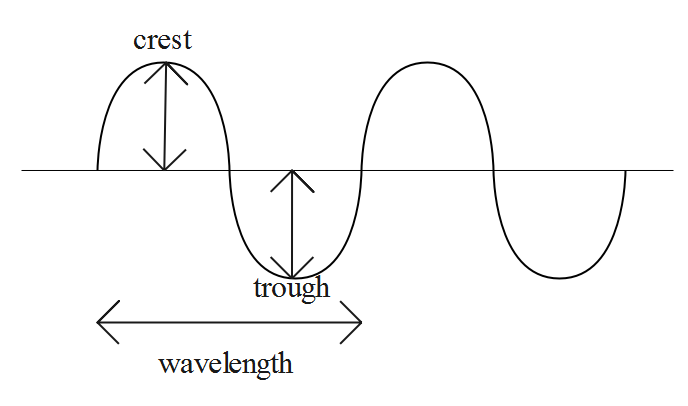
a) Explain the terms crests and troughs of a wave. What type of waves consist of crests and troughs?
Answer
501.3k+ views
Hint: There are two types of mechanical waves, they are longitudinal waves and the transverse waves. Transverse waves are the waves that have direction of propagation perpendicular to the direction of motion. Mechanical waves are the waves that have direction of propagation parallel to the direction of motion.
Complete step-by-step solution:
The crest and trough are the parts of a transverse wave. The wavelength of the wave is a combination of the crest and trough. The positive position where the particle of the wave has maximum displacement. The negative position where the particle of the wave has minimum displacement. The diagram representation of the same is given as follows.

\[\therefore \] The positive position where the particle of the wave has maximum displacement. The negative position where the particle of the wave has minimum displacement.
Note: The main types of waves are mechanical waves and non mechanical waves. Mechanical waves are the waves that need the medium for the propagation, whereas, the non mechanical waves are the waves that do not need a medium for propagation. Mechanical waves cannot travel through vacuum, whereas, the non mechanical waves can travel through the vacuum.
Complete step-by-step solution:
The crest and trough are the parts of a transverse wave. The wavelength of the wave is a combination of the crest and trough. The positive position where the particle of the wave has maximum displacement. The negative position where the particle of the wave has minimum displacement. The diagram representation of the same is given as follows.

\[\therefore \] The positive position where the particle of the wave has maximum displacement. The negative position where the particle of the wave has minimum displacement.
Note: The main types of waves are mechanical waves and non mechanical waves. Mechanical waves are the waves that need the medium for the propagation, whereas, the non mechanical waves are the waves that do not need a medium for propagation. Mechanical waves cannot travel through vacuum, whereas, the non mechanical waves can travel through the vacuum.
Recently Updated Pages
Master Class 11 Chemistry: Engaging Questions & Answers for Success

Why are manures considered better than fertilizers class 11 biology CBSE

Find the coordinates of the midpoint of the line segment class 11 maths CBSE

Distinguish between static friction limiting friction class 11 physics CBSE

The Chairman of the constituent Assembly was A Jawaharlal class 11 social science CBSE

The first National Commission on Labour NCL submitted class 11 social science CBSE

Trending doubts
What is meant by exothermic and endothermic reactions class 11 chemistry CBSE

10 examples of friction in our daily life

One Metric ton is equal to kg A 10000 B 1000 C 100 class 11 physics CBSE

Difference Between Prokaryotic Cells and Eukaryotic Cells

What are Quantum numbers Explain the quantum number class 11 chemistry CBSE

1 Quintal is equal to a 110 kg b 10 kg c 100kg d 1000 class 11 physics CBSE




